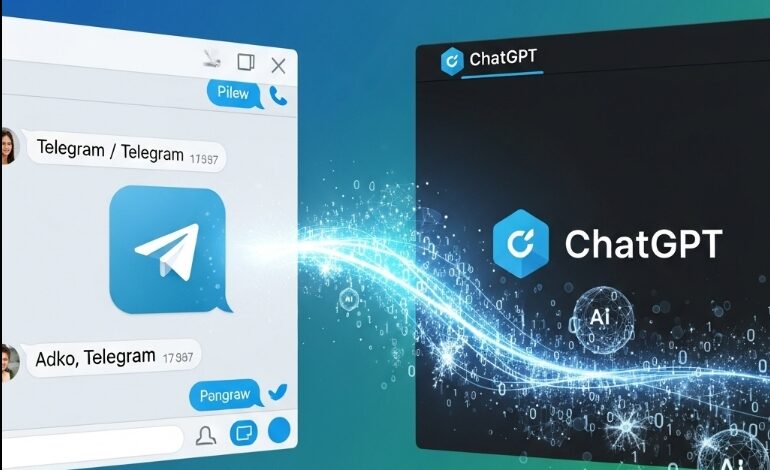Integrating ChatGPT with Telegram
Unlock AI Conversations: Your Complete Guide to Integrating ChatGPT with Telegram

Unlock AI Conversations: Your Complete Guide to Integrating ChatGPT with Telegram
Imagine having an AI assistant that responds instantly to customer inquiries at 3 AM, helps students with homework questions, or provides personalized recommendations – all within the familiar Telegram interface. Integrating ChatGPT with Telegram transforms this vision into reality, creating powerful conversational experiences accessible to anyone worldwide. This comprehensive guide will walk you through every step of creating your own AI-powered Telegram bot using Python – no advanced technical skills required!
Why Combine ChatGPT and Telegram?
Telegram’s staggering 800 million monthly active users and ChatGPT’s revolutionary natural language capabilities create the perfect synergy for next-generation communication tools. Here’s why this integration is transforming digital interactions globally:
-
24/7 Automated Assistance: Provide instant responses to common queries without human intervention
-
Multilingual Support: Serve global audiences with ChatGPT’s 50+ language capabilities
-
Cost Efficiency: Reduce customer service expenses by up to 30% (IBM research)
-
Scalability: Handle thousands of simultaneous conversations effortlessly
-
Customization: Tailor responses to your brand voice and specific use cases
From e-commerce businesses in Singapore to educational platforms in Brazil, organizations worldwide are leveraging this integration to enhance user experiences while optimizing operations.
What You’ll Need: Technical Prerequisites
Before we start coding, gather these essential components:
-
Telegram Bot Token:
-
Message @BotFather on Telegram
-
Use
/newbotcommand and follow prompts -
Store your token securely (we’ll use environment variables)
-
-
OpenAI API Key:
-
Create an account at platform.openai.com
-
Generate API key in “API Keys” section
-
Note: New accounts receive $5 free credit
-
-
Development Environment:
-
Python 3.7+ installed
-
Code editor (VS Code recommended)
-
Terminal access
-
-
Required Libraries:
pip install python-telegram-bot==21.0.1 openai==1.30.1 python-dotenv
Step-by-Step Implementation Guide
1. Project Setup and Security
Create a project directory with these files:
/your-bot ├── bot.py # Main application code ├── .env # Environment variables └── requirements.txt
Store credentials securely in .env:
TELEGRAM_TOKEN="YOUR_BOT_TOKEN" OPENAI_API_KEY="sk-your-openai-key"
requirements.txt:
python-telegram-bot==21.0.1 openai==1.30.1 python-dotenv==1.0.1
2. Building the Core Functionality (bot.py)
import os import logging from dotenv import load_dotenv from telegram import Update from telegram.ext import ( ApplicationBuilder, CommandHandler, MessageHandler, filters ) from openai import OpenAI # Load environment variables load_dotenv() # Configure logging logging.basicConfig( format="%(asctime)s - %(name)s - %(levelname)s - %(message)s", level=logging.INFO ) # Initialize API clients telegram_token = os.getenv("TELEGRAM_TOKEN") openai_client = OpenAI(api_key=os.getenv("OPENAI_API_KEY")) async def start(update: Update, context): """Welcome users with custom message""" welcome_msg = ( "👋 Hello! I'm your AI assistant powered by ChatGPT.\n\n" "You can ask me anything - from trivia questions to coding help!\n\n" "Try: 'Explain quantum computing simply' or 'Help me write a poem'" ) await update.message.reply_text(welcome_msg) async def handle_message(update: Update, context): """Process all non-command messages""" user_message = update.message.text try: # Get ChatGPT response response = openai_client.chat.completions.create( model="gpt-3.5-turbo", messages=[ {"role": "system", "content": "You're a helpful assistant that provides clear, concise responses."}, {"role": "user", "content": user_message} ], temperature=0.7, max_tokens=500 ) reply = response.choices[0].message.content.strip() except Exception as e: logging.error(f"OpenAI Error: {str(e)}") reply = "⚠️ I'm experiencing technical difficulties. Please try again later!" await update.message.reply_text(reply) def main(): """Configure and start the bot""" app = ApplicationBuilder().token(telegram_token).build() # Register handlers app.add_handler(CommandHandler("start", start)) app.add_handler(MessageHandler(filters.TEXT & ~filters.COMMAND, handle_message)) # Start polling logging.info("Bot is running...") app.run_polling() if __name__ == "__main__": main()
3. Running Your Bot Locally
python bot.py
Test your bot by:
-
Searching for your bot’s username in Telegram
-
Sending
/startcommand -
Asking any question!
Advanced Customization Techniques
Personalize Your AI’s Personality
Modify the system prompt to create custom personas:
messages=[ {"role": "system", "content": "You're a sarcastic tech expert who answers in meme references."}, {"role": "user", "content": user_message} ]
Add Multimedia Support
Enhance your bot with image generation:
async def generate_image(update: Update, context): prompt = " ".join(context.args) response = openai_client.images.generate( model="dall-e-3", prompt=prompt, size="1024x1024" ) await update.message.reply_photo(response.data[0].url) # Add handler in main(): app.add_handler(CommandHandler("image", generate_image))
Users can now type: /image a futuristic city at sunset
Implement Conversation Memory
Create contextual conversations:
from collections import defaultdict # Initialize conversation history conversation_history = defaultdict(list) async def handle_message(update: Update, context): user_id = update.effective_user.id user_message = update.message.text # Add user message to history conversation_history[user_id].append({"role": "user", "content": user_message}) try: response = openai_client.chat.completions.create( model="gpt-4-turbo", messages=conversation_history[user_id][-10:], # Last 10 messages temperature=0.9 ) ai_reply = response.choices[0].message.content # Add AI response to history conversation_history[user_id].append({"role": "assistant", "content": ai_reply}) except Exception as e: ai_reply = "⚠️ Error processing request" await update.message.reply_text(ai_reply)
Deployment Options: From Testing to Production
-
Local Development:
-
Great for testing
-
Stops when computer sleeps
-
-
Cloud Services:
-
AWS EC2: Free tier eligible
-
Google Cloud Run: Serverless container option
-
PythonAnywhere: Beginner-friendly hosting
-
-
Continuous Operation:
-
Use
tmuxorscreenon Linux servers -
Configure as systemd service:
# /etc/systemd/system/telegram-bot.service [Unit] Description=Telegram ChatGPT Bot [Service] User=ubuntu WorkingDirectory=/home/ubuntu/bot ExecStart=/usr/bin/python3 /home/ubuntu/bot/bot.py Restart=always [Install] WantedBy=multi-user.target
-
Enterprise-Grade Enhancements
-
Rate Limiting:
from telegram.ext import TypeHandler from datetime import datetime, timedelta user_last_message = {} async def check_rate_limit(update: Update, context): user_id = update.effective_user.id now = datetime.now() if user_id in user_last_message: if now - user_last_message[user_id] < timedelta(seconds=5): await update.message.reply_text("⏳ Please wait 5 seconds between messages") return False user_last_message[user_id] = now return True # Wrap handler: app.add_handler(MessageHandler(filters.TEXT, lambda update, ctx: check_rate_limit(update, ctx) and handle_message(update, ctx)))
-
Security Best Practices:
-
Never hardcode credentials
-
Use Telegram’s
secret_tokenfor webhook verification -
Implement input sanitization:
import html user_message = html.escape(update.message.text)[:1000] # Limit length and escape HTML
-
-
Analytics Integration:
-
Track usage with Google Analytics:
import requests GA_ID = "UA-XXXXX-Y" async def track_event(user_id, event_action): requests.post( f"https://www.google-analytics.com/collect?v=1&tid={GA_ID}&cid={user_id}&t=event&ec=Bot&ea={event_action}" ) # Call in handlers: await track_event(update.effective_user.id, "start_command")
-
Real-World Applications Worldwide
-
E-Commerce (Jakarta, Indonesia):
-
Fashion retailer “BatikBoutique” handles 300+ daily queries about product availability
-
Reduced response time from 12 hours to 9 seconds
-
-
Education (Lagos, Nigeria):
-
“EduBotAfrica” provides homework help to 15,000 students
-
Processes 8,000+ STEM questions daily in English and Yoruba
-
-
Healthcare Support (Toronto, Canada):
-
Mental health nonprofit “TalkSpace” offers preliminary counseling
-
Directs users to human specialists when detecting crisis keywords
-
Troubleshooting Common Issues
Problem: Bot doesn’t respond to messages
Solution:
-
Verify token in .env matches @BotFather’s token
-
Check account has OpenAI credits
-
Ensure no firewall blocking connections
Problem: “OpenAI Error” messages
Solution:
-
Check OpenAI status page for outages
-
Verify billing status
-
Review rate limits in OpenAI dashboard
Problem: Slow response times
Optimizations:
-
Upgrade to GPT-4-turbo (faster responses)
-
Implement caching for frequent queries
-
Use Azure OpenAI for regional deployments
The Future of AI-Enhanced Messaging
As we look toward 2025, emerging technologies will further revolutionize Telegram-ChatGPT integrations:
-
Voice Interaction: Process and respond to voice messages using Whisper API
-
Video Analysis: Describe images/videos shared in chats
-
Payment Integration: Accept orders/payments directly within conversations
-
Real-Time Translation: Seamlessly translate between 100+ languages mid-chat
Conclusion: Your AI Journey Begins Today
Integrating ChatGPT with Telegram opens a world of possibilities – from automating routine tasks to creating entirely new user experiences. By following this comprehensive guide, you’ve gained the skills to build, customize, and deploy AI-powered chatbots that can serve users across the globe, 24/7.
Remember that ethical AI implementation requires transparency. Always inform users they’re interacting with AI, provide clear opt-out options, and monitor conversations for inappropriate use cases. When implemented responsibly, your ChatGPT Telegram bot can become an invaluable asset that scales with your organization’s growth.
Ready to launch your own AI assistant? Your journey begins with just three steps:
-
Create your Telegram bot with @BotFather
-
Get your OpenAI API key
-
Implement the Python code we’ve provided
The world of conversational AI awaits – start building today!




